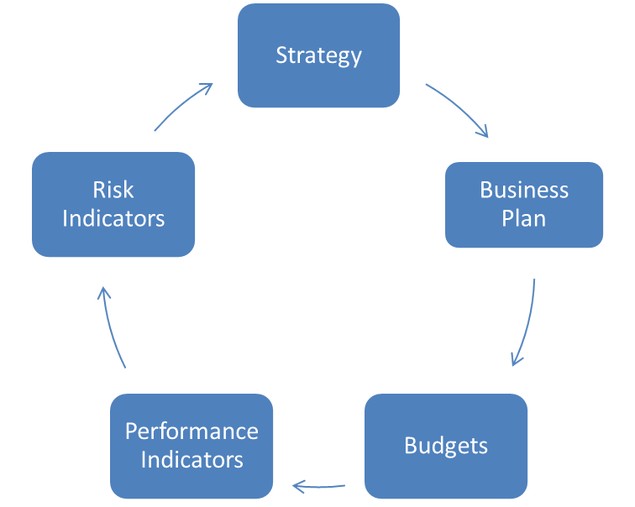In December, senior management focuses on formulating strategies. Department heads prepare business plans and budgets. Risk management departments define the next year’s agenda and plans. Everyone works hard at planning and preparing for the coming year. However, most of the efforts are in vain and result in failure. The problem is that generally people do these activities independently and make no attempt to align them. The ideal integrated sequence is below.
However, this does not happen. For instance, department heads do capital expenditures while ignoring the strategy. Business teams define performance indicators and risk managers establish risk indicators, without syncing the two indicators. Situations occur where desired performance is achieved at very high-risk levels. Business teams ignore the risk levels until disaster occurs. With the multitude of unsynchronized management information, boards make incorrect decisions with information overload. Hence, at the end of the year only a few organizations can claim that they achieved the strategy and targets.
The Chief Financial Officers (CFOs) can play a pivotal role in bringing the different facets together. CFOs sit on the board and participate in the strategy formation process. Department heads submit their plans and budgets to CFOs for review and consolidation. Generally, Chief Audit Executives (CAE) administrative reporting is to the CFO. Quite frequently, CFOs act as defacto Chief Risk Officers (CRO). Hence, CFOs can put the jigsaw puzzle together. The key things they need to look into to revamp the process are as follows:

1. Strategy Formulation
The common misperception is that organizations have a proper strategy formation process. In reality, the ideas supported by the CEO and politically strong CXOs are adopted without much constructive discussion since no one wishes to rock the boat. Secondly, a formal strategy process is not in place in most organizations. Moreover, at the time of strategy formation upside and downside risks remain unidentified, as CXOs do not invite CRO to the discussion. The CFOs can influence the other CXOs to implement a formal strategy development process and conduct a strategic risk assessment in each phase of strategy formation.
2. Business Plans
While strategies are for 3-5 year period, business plans are drawn annually. However, the changing business landscape makes business plans redundant on formation. Reason being that business plans are prepared on a set of assumptions on customer behavior engagement and market situation. Real interaction with customers and entry into the market prove most of the assumptions incorrect. Additionally, department heads make independent business plans to show one up man ship. Hence, performance objectives are missed and risks remain unidentified. The need of the hour is for businesses to react fast and give cohesive messages in response to market changes. Therefore, CFOs must make the business planning process dynamic and integrated.
3. Budgets
More than 60% of the organizations are unsatisfied with their ability to link strategy to operating budgets. Additionally, organizations spend 4 to 6 months in preparing budgets with numerous iterations back and forth between departments. Meanwhile the business plans change due to the volatility in the market. Hence, organizations are feeling the need of speed in the budgeting and forecasting process. CFOs must adopt rolling forecasts rather than static budgets to improve planning and control. Rather than doing post facto variance analysis they can collaborate with business teams to give real-time analysis.
4. Performance Indicators
Performance indicators measure the reward side of the strategy. Without the risk indicators, they give an incomplete picture of business status. Another aspect is that performance indicators and risk indicators for the same strategy or plan are not aligned together and are reported at different periods. Organizations sometimes continue to measure redundant parts and do not update the indicators with change in strategy and objectives. A prime example is the financial crises. A few banks achieved performance targets without understanding the risk levels. Hence, CFOs must use technology to create relevant dashboards to monitor indicators to keep a firm grasp on the business.
5. Risk Indicators
Risk managers fail to address the twin shortcomings in process of identifying key risk indicators. Firstly, risk managers do not ascertain strategic risk indicators. Secondly, a lot of meaningless indicators are created which do not really find out the overall business risks. Hence, CXOs fail to separate the noise from the inflection points. Moreover, Nassim Taleb’s point of view that most significant risks are unpredictable needs to be thought over. There might be too much data available and organizations might look at risk indicators they are comfortable with, until the bubble bursts. CFOs can identify key risk indicators for strategy and business plans, and synchronize them to performance indicators. That will close the loop and move the business in the right direction.
Closing Thoughts
Synchronizing multiple factors between strategy and indicators influences a company’s capacity to achieve goals. With predictions of recession and volatile business environment, dropping the ball is highly probable. Understanding which economic predictions to rely on, which market trends will impact long-term and what are the strategic inflection points, spells the difference between success and failure. Hence, CFOs must play the vital role of coordinating and aligning various steps between strategy formation and identifying indicators.
Author: Sonia Jaspal is a chartered accountant and certified public accountant with +15 years of experience in risk management and corporate governance. She blogs at Sonia Jaspal's RiskBoard








 CAclubindia
CAclubindia
